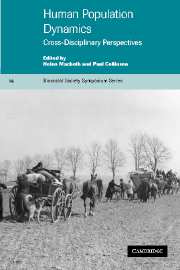Book contents
- Frontmatter
- Contents
- List of contributors
- Foreword by G.A. Harrison
- Preface
- 1 Introduction: the framework of studying human population dynamics
- 2 Demographic perspectives on human population dynamics
- 3 The growing concentration of world population from 1950 to 2050
- 4 Population, community and society in peasant societies
- 5 From genetic variation to population dynamics: insights into the biological understanding of humans
- 6 Social institutions and demographic regimes in non-industrial societies: a comparative approach
- 7 The dynamics of child survival
- 8 Genetic structure of south Indian caste populations: a confluence of biology and culture
- 9 Fertility, mortality and migration transitions in association with socioeconomic modernisation among highland minority populations in Southeast Asia
- 10 Ecology, homeostasis and survival in human population dynamics
- Glossary
- Index
Foreword by G.A. Harrison
Published online by Cambridge University Press: 11 August 2009
- Frontmatter
- Contents
- List of contributors
- Foreword by G.A. Harrison
- Preface
- 1 Introduction: the framework of studying human population dynamics
- 2 Demographic perspectives on human population dynamics
- 3 The growing concentration of world population from 1950 to 2050
- 4 Population, community and society in peasant societies
- 5 From genetic variation to population dynamics: insights into the biological understanding of humans
- 6 Social institutions and demographic regimes in non-industrial societies: a comparative approach
- 7 The dynamics of child survival
- 8 Genetic structure of south Indian caste populations: a confluence of biology and culture
- 9 Fertility, mortality and migration transitions in association with socioeconomic modernisation among highland minority populations in Southeast Asia
- 10 Ecology, homeostasis and survival in human population dynamics
- Glossary
- Index
Summary
Evolutionary biology became gradually transformed through the twentieth century from what was termed ‘typological thinking’ to ‘population thinking’. This happened from the increasing recognition that differences between individuals were as important as similarities. Variation contains the raw material of evolution and variation can exist only in populations. The transformation harmonised the relationship of evolutionary biology with other population based biologies: genetics, ecology and epidemiology, for example. More significantly, however, in humans it also established potential connections with some of the social sciences and especially sociology, social anthropology, human geography and social psychology, all of which are fundamentally population based areas of knowledge.
Population can thus be seen as a bridge between the ‘two cultures’ of natural sciences and the humanities. This was most effectively recognised by J.W.S. Pringle at Oxford, who was instrumental in establishing there the field of Human Sciences, essentially based on the analysis of human population structures from all perspectives. In the past twenty-five years the field has developed dramatically.
The concept of population is not, however, one without difficulties. Even the definition of a population can be a major problem. Human groups rarely exist as discrete, more or less uniform entities even at any one time, and they have never existed over time. Typically they intergrade, often very gradually. Then while one most frequently thinks of populations in some spatial context, they also exist in vertical dimensions such as social class and caste, and in ecological and economic terms reflecting natural environmental heterogeneity.
- Type
- Chapter
- Information
- Human Population DynamicsCross-Disciplinary Perspectives, pp. xiii - xivPublisher: Cambridge University PressPrint publication year: 2002
- 1
- Cited by



